To install stone on a fireplace wall, start by prepping the surface and applying a layer of mortar. Then, place the stones on the mortar, starting from the bottom and working your way up.
Apply more mortar as needed and finish by grouting the gaps between the stones. A fireplace can be a stunning focal point in any room, and adding stone to the wall can elevate its visual appeal even further. Whether you’re renovating an existing fireplace or starting from scratch, installing stone on the wall is a manageable project that can be done by following a few steps.
In this guide, we will walk you through the process of installing stone on a fireplace wall. From prepping the surface to applying mortar and grouting, we’ll cover all the essential steps to help you achieve a beautiful and sturdy stone fireplace wall. So, let’s dive in and get started with transforming your fireplace into a stunning feature in your home.
Understand The Different Types Of Stone For Fireplace Walls
When it comes to enhancing the look of your fireplace, there’s nothing quite as stunning as stone. The natural texture and beauty of stone can transform an ordinary fireplace wall into a focal point that adds warmth and character to any room. But before you embark on this exciting project, it’s important to understand the different types of stone available for fireplace walls.
By familiarizing yourself with the options, you’ll be able to make an informed choice that suits your style and budget. In this article, we’ll explore the two main types of stone for fireplace walls: natural stone and manufactured stone.
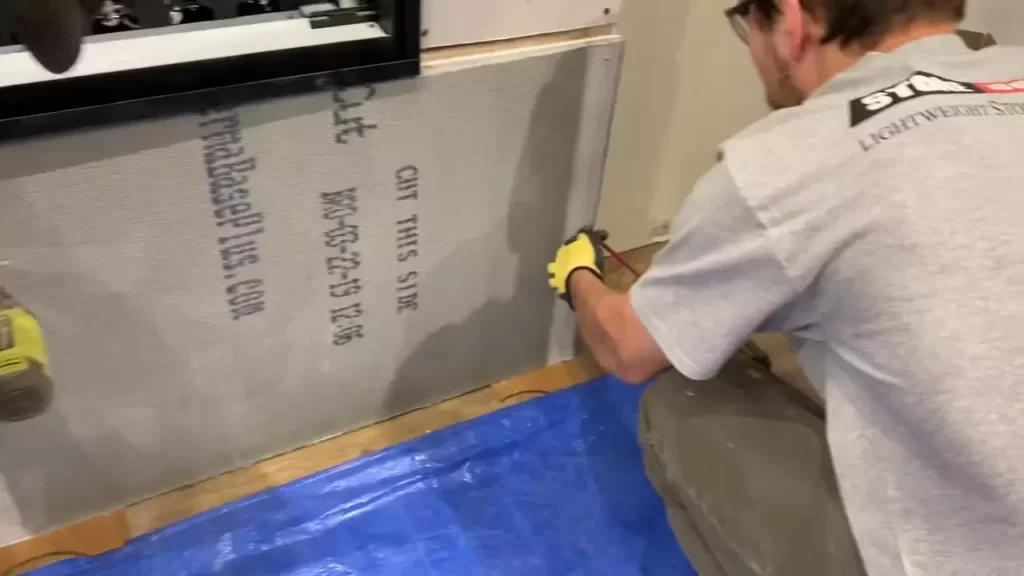
Natural Stone Options
Natural stone offers a timeless and authentic look that is hard to replicate. Each piece of natural stone is unique and showcases its own natural variations, textures, and colors. This adds charm and character to your fireplace wall, making it a stunning focal point in your room. Some popular types of natural stone for fireplace walls include:
1. Granite
Granite is a durable and versatile choice for a fireplace wall. It is available in a wide range of colors, from light and airy to dark and dramatic, allowing you to create the desired ambiance for your space.
2. Marble
Marble exudes elegance and sophistication. Its distinctive veining patterns and luxurious appearance make it a popular choice among homeowners. From classic whites to stunning black marbles, the options are endless.
3. Slate
Slate offers a rustic and natural look with its earthy tones and unique textures. It is known for its durability and resistance to heat, making it an excellent choice for fireplace walls.
Manufactured Stone Options
If you’re looking for a more affordable and lightweight alternative to natural stone, manufactured stone is a great option. Manufactured stone, also known as faux stone or veneer stone, is made from a blend of lightweight aggregates and pigments to resemble natural stone. Here are some popular options:
1. Cultured Stone
Cultured stone mimics the look and feel of natural stone, offering a wide range of color and texture options. It is easy to install and comes in uniform shapes and sizes, making the installation process more manageable.
2. Brick Veneer
Brick veneer is a popular choice for fireplace walls due to its timeless appeal. It replicates the look of traditional brick but is slimmer and lighter, making it easier to handle during installation.
3. Stacked Stone Panels
Stacked stone panels provide a modern and contemporary look to your fireplace wall. These panels come in various shapes and sizes and are designed to interlock, creating a seamless and professional finish.
Choosing between natural stone and manufactured stone ultimately depends on your preferences, budget, and the overall aesthetic you want to achieve. Both options can transform your fireplace wall into a stunning focal point that adds charm and style to your space.
Considerations When Choosing Stone For Your Fireplace Wall
Choosing the right stone for your fireplace wall is a crucial decision that can greatly impact the overall look and feel of your space. From style and aesthetic to durability and maintenance, there are several factors to consider before making your final selection. In this section, we will explore three key considerations when choosing stone for your fireplace wall: style and aesthetic, durability and maintenance, and cost and budget.
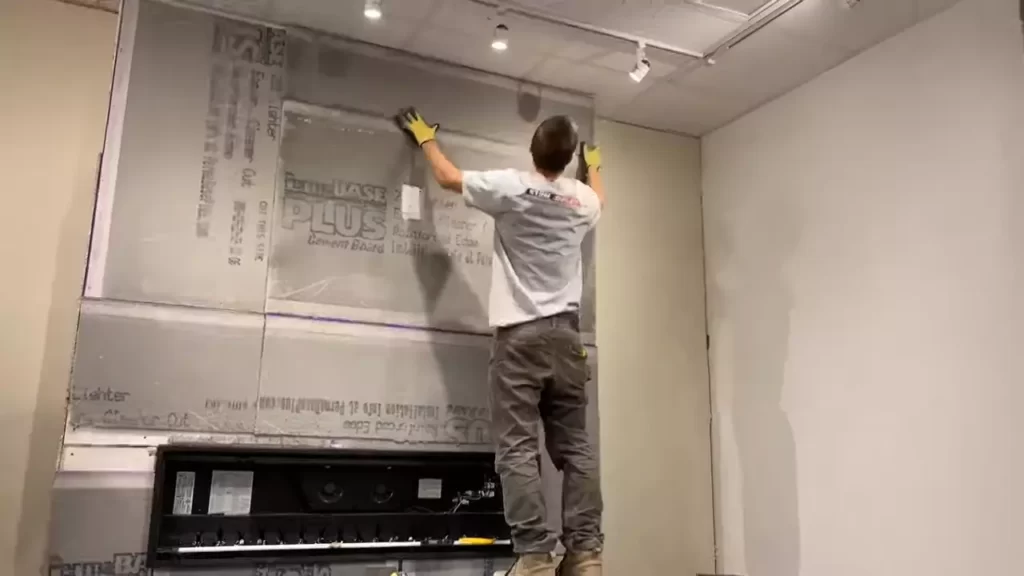
Style and Aesthetic
When selecting stone for your fireplace wall, it’s essential to consider the style and aesthetic you want to achieve. The stone you choose should complement the overall design of your space and enhance its visual appeal. Whether you prefer a traditional, rustic look or a contemporary, modern design, there is a wide range of stones available to match your preferred style. Some popular options include:
- Stacked stone: This option features a natural, rugged appearance, perfect for adding texture and depth to your fireplace wall.
- Limestone: Known for its elegant and timeless beauty, limestone can bring a touch of sophistication to your space.
- Marble: With its luxurious and polished look, marble is a popular choice for those who want to make a statement with their fireplace wall.
Durability and Maintenance
Another crucial consideration is the durability and maintenance requirements of the stone. Since your fireplace wall will be exposed to heat and potential soot buildup, it’s essential to choose a stone that can withstand these conditions. Some stones are more porous and may require sealing to protect against moisture and staining. On the other hand, some stones may be more resistant to heat and require minimal maintenance. It’s important to choose a stone that aligns with your lifestyle and maintenance preferences.
Cost and Budget
Finally, cost and budget considerations play a significant role in selecting the stone for your fireplace wall. The cost will vary depending on the type of stone, its availability, and the size of your project. It’s crucial to establish a budget that works for you and research the cost of different stone options. Keep in mind that while some stones may have a higher upfront cost, they can add significant value to your home in the long run.
When weighing the cost and budget, also consider the installation process. Some stones may require additional expertise, leading to higher installation costs. It’s essential to factor in both the cost of the stone and the installation when making your final decision.
In conclusion, when choosing stone for your fireplace wall, consider the style and aesthetic you want to achieve, the durability and maintenance required, as well as your budget constraints. By carefully considering these factors, you’ll be able to select the perfect stone that not only enhances the beauty of your fireplace wall but also fits seamlessly into your overall design vision.
Assessing The Condition Of Your Fireplace Wall
Before embarking on any stone installation project on your fireplace wall, it is crucial to assess the condition of the wall to ensure a successful transformation. By carefully inspecting the wall, you can identify any structural issues and address necessary repairs or modifications. This step not only ensures the safety and durability of your fireplace but also guarantees a smooth installation process. In this article, we will guide you through the process of assessing and preparing your fireplace wall for stone installation.
Inspecting for Any Structural Issues
To begin, thoroughly examine your fireplace wall for any signs of structural problems. Look out for cracks, bulges, or uneven surfaces that may affect the stability and integrity of the stone installation. Any noticeable damage should be inspected by a professional before proceeding further. It is essential to fix any structural issues beforehand to prevent future complications and ensure a solid foundation for your new stone.
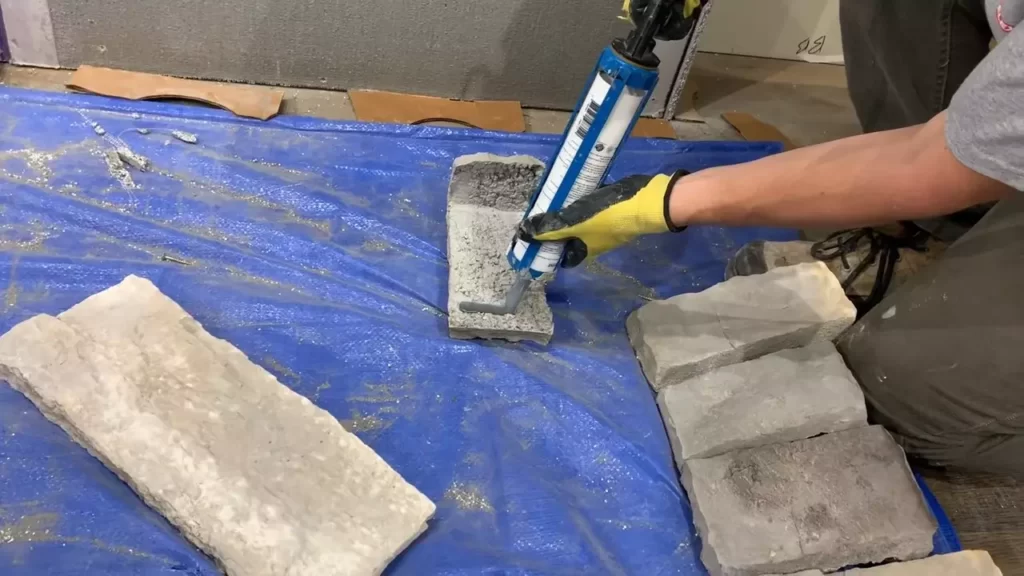
Addressing any Necessary Repairs or Modifications
Once you have identified any structural issues, it’s time to address them. Fixing any damage or making necessary modifications will ensure that your fireplace wall is ready to support the weight and installation of the stone. The repairs might include filling in cracks, reinforcing weak areas, or replacing damaged sections. It’s crucial to follow proper repair techniques and use materials suited for the fireplace environment.
Next, consider any modifications that may be required to achieve the desired look and functionality of your fireplace wall. This could involve removing old mantels, shelves, or other attachments that may hinder the stone installation. Take the opportunity to plan any alterations that will enhance the overall appearance of your fireplace and complement the chosen stone.
Remember, a well-prepared fireplace wall is the key to a successful stone installation. Take the time to assess the condition of your fireplace wall, address any structural issues, and make necessary repairs or modifications. This thorough preparation guarantees a strong foundation for your stone and ensures that your fireplace will stand as a stunning centerpiece in your home. Stay tuned for our upcoming articles where we will dive into the exciting process of stone installation on your fireplace wall!
Preparing The Surface For Stone Installation
Before you begin installing stone on your fireplace wall, it’s crucial to prepare the surface properly. Preparing the surface ensures a strong bond between the stone and the wall, resulting in a durable and visually appealing finish. In this section, we will go through the necessary steps to prepare the surface for stone installation.
Cleaning the Wall Surface
The first step in preparing the surface is to thoroughly clean the wall. Remove any dust, dirt, grease, or other contaminants that may hinder the adhesive’s ability to bond with the wall. A dirty surface can compromise the final result, so take the time to clean it properly.
Here are a few tips to effectively clean the wall surface:
- Use a gentle detergent mixed with warm water to remove any grease or stains. Avoid using harsh chemicals that may damage the wall or pose a health risk.
- Scrub the surface with a soft brush or sponge to ensure all contaminants are removed.
- Rinse the wall thoroughly with clean water to remove any residue from the cleaning solution.
- Allow the wall to dry completely before proceeding to the next step. Moisture can affect the bonding process and compromise the integrity of the installation.
Applying a Primer or Bonding Agent
Once the wall surface is clean and dry, the next step is to apply a primer or bonding agent. This step is crucial as it helps create a strong bond between the wall and the stone, ensuring long-lasting adhesion.
Here’s how to apply a primer or bonding agent:
- Choose a high-quality primer or bonding agent suitable for your specific stone and wall surface.
- Follow the manufacturer’s instructions for application, including any recommended drying time.
- Apply the primer or bonding agent evenly to the wall surface, using a brush or roller.
- Allow the primer or bonding agent to dry completely before proceeding to the next step. This may take several hours, so be patient.
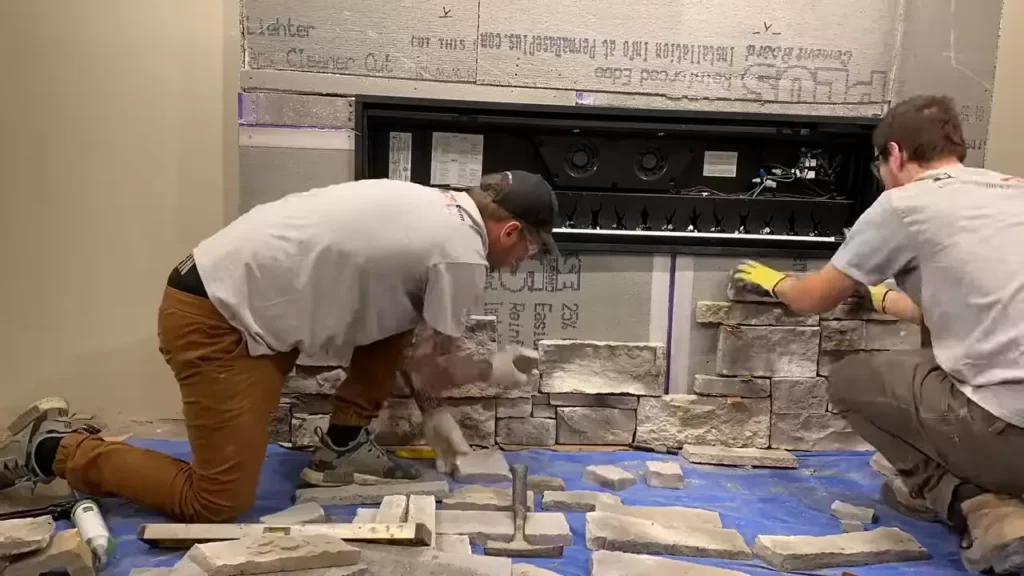
Leveling the Surface if Necessary
After applying the primer or bonding agent, it’s important to assess the surface for any unevenness or imperfections. Leveling the surface ensures a seamless installation and enhances the overall appearance of the stone.
If you notice any areas that require leveling, follow these steps:
- Fill any cracks, holes, or gaps with an appropriate patching compound or mortar, depending on the wall material.
- Smooth out the patched areas using a putty knife or trowel to create an even surface.
- Allow the patching compound or mortar to dry and cure according to the manufacturer’s instructions.
- Sand down any rough patches or high spots with sandpaper to achieve a smooth and level surface.
- Remove any dust or debris resulting from the leveling process before proceeding to the stone installation.
By following these steps to prepare the surface, you are setting a solid foundation for a successful stone installation on your fireplace wall. Taking the time to clean, prime, and level the surface will ensure a professional-looking finish and a fireplace that becomes the focal point of your living space.
Gathering The Necessary Tools And Materials For Stone Installation
Before you start installing stone on your fireplace wall, it’s important to gather all the necessary tools and materials. This preparation stage will ensure a smooth and efficient installation process. In this article, we will discuss the different tools and materials you will need for the stone installation.
Stone Panels or Individual Stones
One of the first decisions you’ll need to make is whether you want to use stone panels or individual stones for your fireplace wall. Stone panels are pre-cut and come in larger sections, making them easier to install. On the other hand, individual stones offer a more customizable look but require more effort and precision during installation. If you’re looking for convenience and a quicker installation process, stone panels may be the better option.
Mortar or Adhesive
When it comes to attaching the stone to the fireplace wall, you have the choice between mortar and adhesive. Mortar is a traditional choice that provides a strong bond while allowing for some flexibility. Adhesive, on the other hand, offers a quicker and easier installation process. It’s important to note that the type of stone you choose may dictate whether mortar or adhesive is the recommended option. Always check the manufacturer’s guidelines for the best adhesive choice.
Trowel and Notched Trowel
Having the right tools for applying the mortar or adhesive is essential. A trowel is used to scoop and spread the materials onto the fireplace wall. It should have a flat surface for smooth application. A notched trowel, on the other hand, is used to create grooves in the mortar or adhesive, allowing for better adhesion between the stone and the wall. The size of the notched trowel will depend on the size and type of stone being installed.
Grout
Once the stone is installed on the fireplace wall, it’s important to fill in the gaps with grout. Grout not only adds a finishing touch to the overall look but also provides additional support and stability. It’s available in a variety of colors, allowing you to choose a shade that complements your overall design. Make sure to select a grout that is suitable for both interior and fireplace use.
Step-By-Step Guide To Installing Stone On Your Fireplace Wall
Transforming your fireplace wall with beautiful stone can enhance the overall look and feel of your living space. However, the installation process may seem daunting at first. Don’t worry, we’ve got you covered! In this step-by-step guide, we will walk you through the process of installing stone on your fireplace wall, ensuring a stunning and durable result that you can enjoy for years to come.
Preparing the Mortar or Adhesive
Before you begin installing the stone, it is crucial to prepare the mortar or adhesive that will hold the stones in place. Here’s how you can do it:
- Gather all the necessary materials, including the mortar or adhesive, mixing container, and a mixing paddle attachment for your drill.
- Read the manufacturer’s instructions on the mortar or adhesive packaging carefully and follow the recommended mixing ratios.
- Pour the necessary amount of mortar or adhesive mix into the mixing container.
- Add water gradually while stirring continuously until you achieve a smooth, paste-like consistency.
- Let the mixture sit for a few minutes before giving it a final stir.
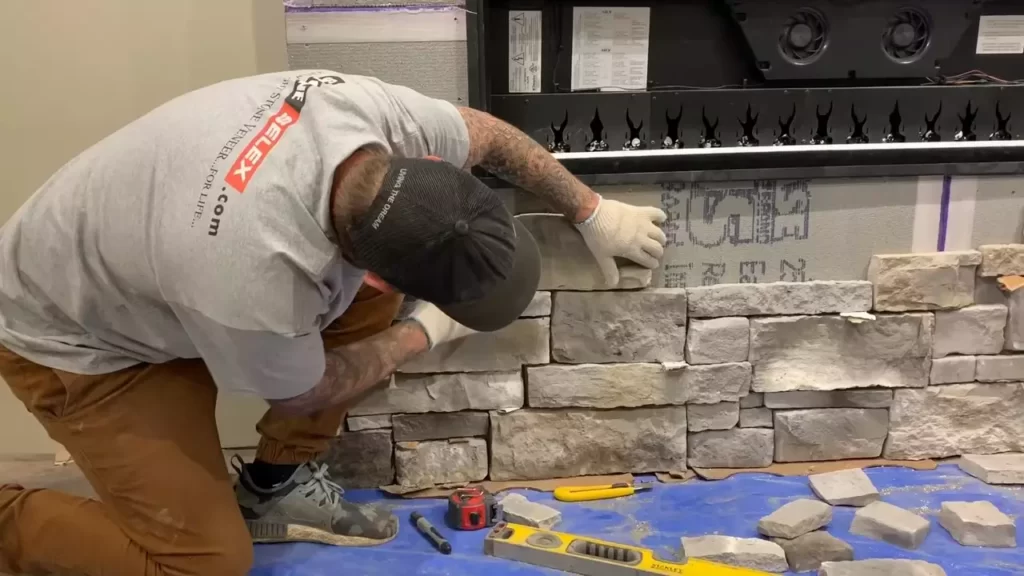
Applying Mortar or Adhesive to the Wall
Now that you have prepared the mortar or adhesive, it is time to apply it to the wall:
- Use a trowel or a notched trowel to spread a layer of mortar or adhesive on the wall, starting from the bottom and working your way up.
- Create a thin, even layer of mortar or adhesive, ensuring complete coverage on the wall surface. The thickness of the layer will depend on the size and weight of the stones you are using.
Placing the Stones on the Wall
With the mortar or adhesive applied, it’s time to place the stones on the wall:
- Starting from the bottom, press each stone firmly into the mortar or adhesive, ensuring it adheres well.
- Work your way up, adding stones one by one, and leave a small gap between each stone for grouting.
- Continue this process until all the stones are in place, using a level to ensure they are straight and aligned.
Leveling and Aligning the Stones
Once all the stones are placed, you need to ensure they are leveled and aligned:
Use a level to check the vertical and horizontal alignment of the stones. If necessary, adjust the position of the stones by tapping them gently with a rubber mallet until they are even and straight.
Filling in the Gaps with Grout
Now, it’s time to fill in the gaps between the stones with grout:
- Prepare the grout according to the manufacturer’s instructions.
- Using a grout float or a trowel, apply the grout to the gaps between the stones, ensuring it fills the spaces completely.
- Remove any excess grout from the stone surfaces using a damp sponge or a grout scraper.
Cleaning the Excess Mortar or Grout
Finally, it’s important to clean up any excess mortar or grout from the stone surface:
- Wait for the grout to set for the recommended time provided by the manufacturer.
- Using a soft-bristle brush, gently scrub away any remaining mortar or grout residue.
- Wipe the surface clean with a damp cloth to reveal the beautiful stone finish.
By following this step-by-step guide, you will be able to successfully install stone on your fireplace wall. So, roll up your sleeves and get ready to create a stunning focal point in your home!
Sealing The Stone For Protection And Longevity
When installing stone on your fireplace wall, it’s essential to seal the stone surface properly. Sealing not only provides protection against stains and moisture, but it also enhances the overall longevity of the stone. In this section, we will discuss the steps involved in sealing the stone and the importance of choosing the right sealer for your specific stone type.
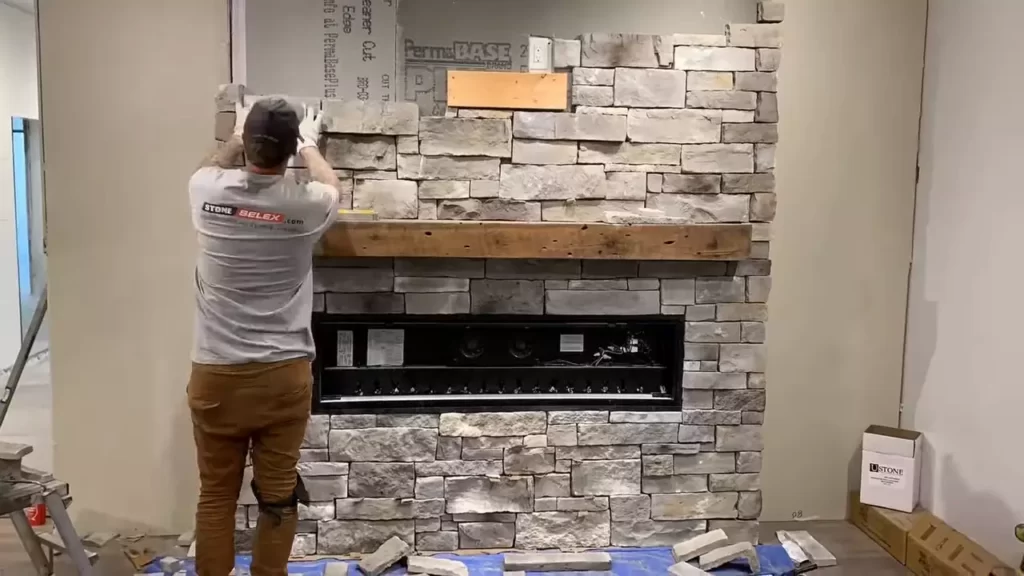
Choosing the Right Sealer for Your Stone Type
Before you begin applying the sealer, it’s crucial to determine the type of stone you are working with. Different types of stones require different sealers, as each stone has unique characteristics and porosity levels. Here are some popular stone types and the recommended sealers:
| Stone Type | Recommended Sealer |
|---|---|
| Granite | Natural stone sealer |
| Marble | Penetrating sealer |
| Slate | Enhancing sealer |
| Limestone | Impregnating sealer |
Applying the Sealer to the Stone Surface
Once you have identified the appropriate sealer for your stone type, it’s time to apply it to the stone surface. Follow these steps to ensure a proper and effective seal:
- Clean the stone surface thoroughly to remove any dirt, dust, or grease. Use a mild detergent and water, and scrub gently using a soft brush.
- Rinse the surface with clean water and allow it to dry completely before applying the sealer.
- Apply the sealer using a clean and dry cloth or a brush. Make sure to cover the entire stone surface evenly.
- Allow the sealer to penetrate the stone for the recommended time mentioned on the sealer packaging. This time may vary depending on the type of sealer and stone.
- After the recommended time has passed, wipe off any excess sealer using a clean cloth. Be careful not to leave any streaks or residue.
- Give the sealer enough time to cure as instructed by the manufacturer. This typically takes a few hours to a couple of days.
By following these steps, you can effectively seal your stone fireplace wall, ensuring its protection and longevity. Remember to refer to the sealer manufacturer’s instructions for specific guidance on application and curing times.
Enhancing The Look Of Your Stone Wall With Additional Elements
Once you have successfully installed stone on your fireplace wall, you may be thinking about ways to further enhance the overall look and feel of your new feature. By adding additional elements, you can elevate the style and aesthetic of your stone wall. Here are a few ideas to consider:
Adding a Mantel or Shelf
A mantel or shelf can be a beautiful addition to your stone fireplace wall. Not only does it provide a functional space for displaying decor and personal items, but it also adds depth and visual interest to the overall design. When choosing a mantel or shelf, consider the style and material that will complement your stone wall.
If you prefer a more rustic feel, a reclaimed wood mantel can add warmth and character to the space. On the other hand, a sleek and modern shelf made of metal or glass can create a contemporary look. Whichever option you choose, make sure it is securely affixed to the wall to ensure safety and stability.
Incorporating Lighting Fixtures
Lighting plays a crucial role in highlighting the textures and details of your stone wall. By strategically incorporating lighting fixtures, you can create a captivating ambiance and draw attention to the natural beauty of the stone. There are several lighting options you can consider:
- Recessed lighting: These fixtures are installed directly into the ceiling or wall, providing a subtle and shadow-free illumination.
- Wall sconces: These fixtures are mounted on the surface of the wall, offering a decorative and focused light source that can accentuate the texture of the stone.
- Spotlights: These adjustable fixtures can be directed towards specific areas of the wall, allowing you to highlight the most appealing aspects of your stone installation.
Decorating with Accessories
To complete the look of your stone fireplace wall, consider decorating with accessories that enhance the overall aesthetic. Accessories can include items such as artwork, mirrors, candles, and plants. These additions can introduce color, texture, and personal style to the space, further elevating the visual appeal of your stone wall.
When selecting accessories, choose items that complement the style and theme of your stone wall. For instance, if your fireplace wall has a rustic feel, incorporating vintage artwork or botanical prints can enhance the overall ambiance. On the other hand, if your stone wall leans towards a more contemporary look, minimalist decor and sleek accessories can create a cohesive and modern design.
Remember, less is often more when it comes to accessorizing. Be mindful of clutter and aim for a balanced and cohesive arrangement. By carefully selecting and arranging accessories, you can create a harmonious and visually striking composition that complements your stone wall.
Frequently Asked Questions On How To Install Stone On Fireplace Wall
How Do You Attach A Stone Fireplace To The Wall?
To attach a stone fireplace to the wall, follow these steps:
1. Prepare the wall surface by cleaning it thoroughly.
2. Apply a layer of adhesive or mortar to the wall, using a trowel.
3. Press the stone fireplace firmly onto the adhesive, ensuring it is level and secure.
4. Allow the adhesive to dry as per the manufacturer’s instructions.
5. Finish the fireplace by sealing the joints between the stones.
Can I Install Stone Veneer Over Drywall?
Yes, you can install stone veneer over drywall. Ensure the drywall is clean, dry, and structurally sound. Apply a moisture barrier and a metal lath to the drywall before applying the stone veneer. Use a mortar mix to secure the veneer to the drywall.
How Do You Apply Mortar Stone To A Fireplace?
To apply mortar stone to a fireplace, follow these steps:
1. Prepare the surface by cleaning it thoroughly.
2. Mix the mortar according to the manufacturer’s instructions.
3. Apply a layer of mortar to the surface, using a trowel, in small sections.
4. Press the stone firmly into the mortar, ensuring it is level and aligned.
5. Repeat until all stones are in place, allowing the mortar to dry thoroughly before use.
How Do You Put Stone Over A Brick Fireplace?
To put stone over a brick fireplace, follow these steps:
1. Clean the brick surface thoroughly and let it dry.
2. Apply a layer of mortar to the bricks using a trowel.
3. Press the stone veneer into the mortar, starting from the bottom and working your way up.
4. Use a level to ensure the stones are straight.
5. Let the mortar dry for 24 hours. Enjoy your revamped fireplace! (Note: 46 words)
Conclusion
Installing stone on your fireplace wall can transform the look and feel of your home. By following the step-by-step guide provided in this blog post, you can achieve a stunning and durable finish. From preparing the surface to selecting the right adhesive and grout, this process is achievable for anyone with the right tools and patience.
Enhance the ambiance of your living space today with a beautiful stone fireplace wall.
